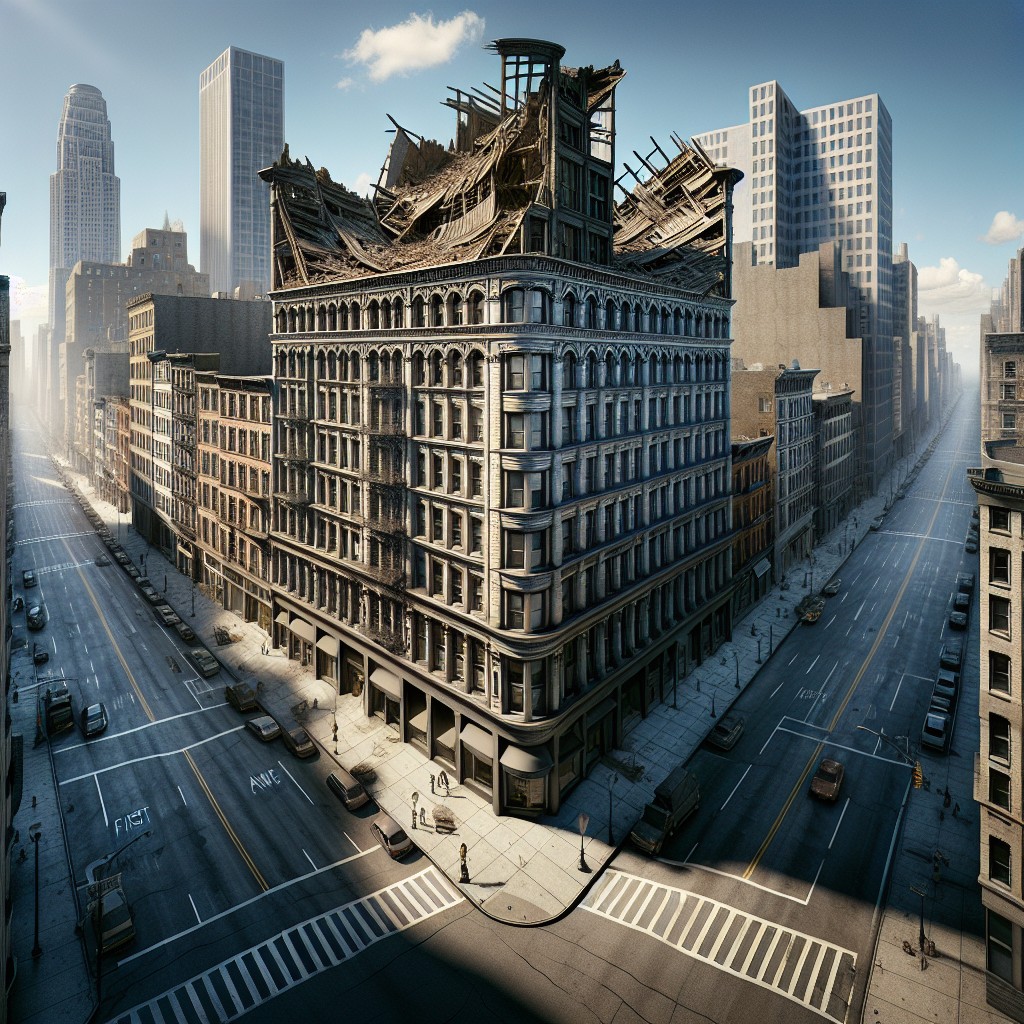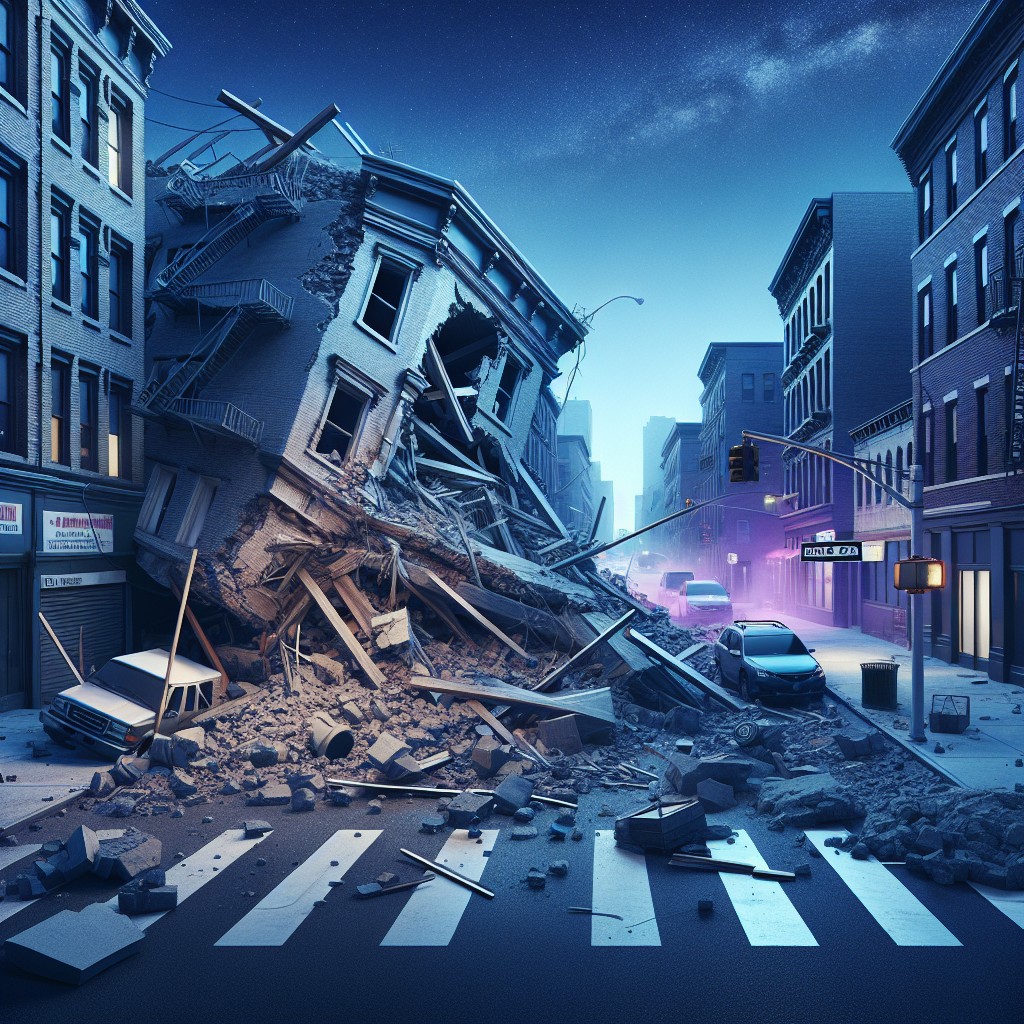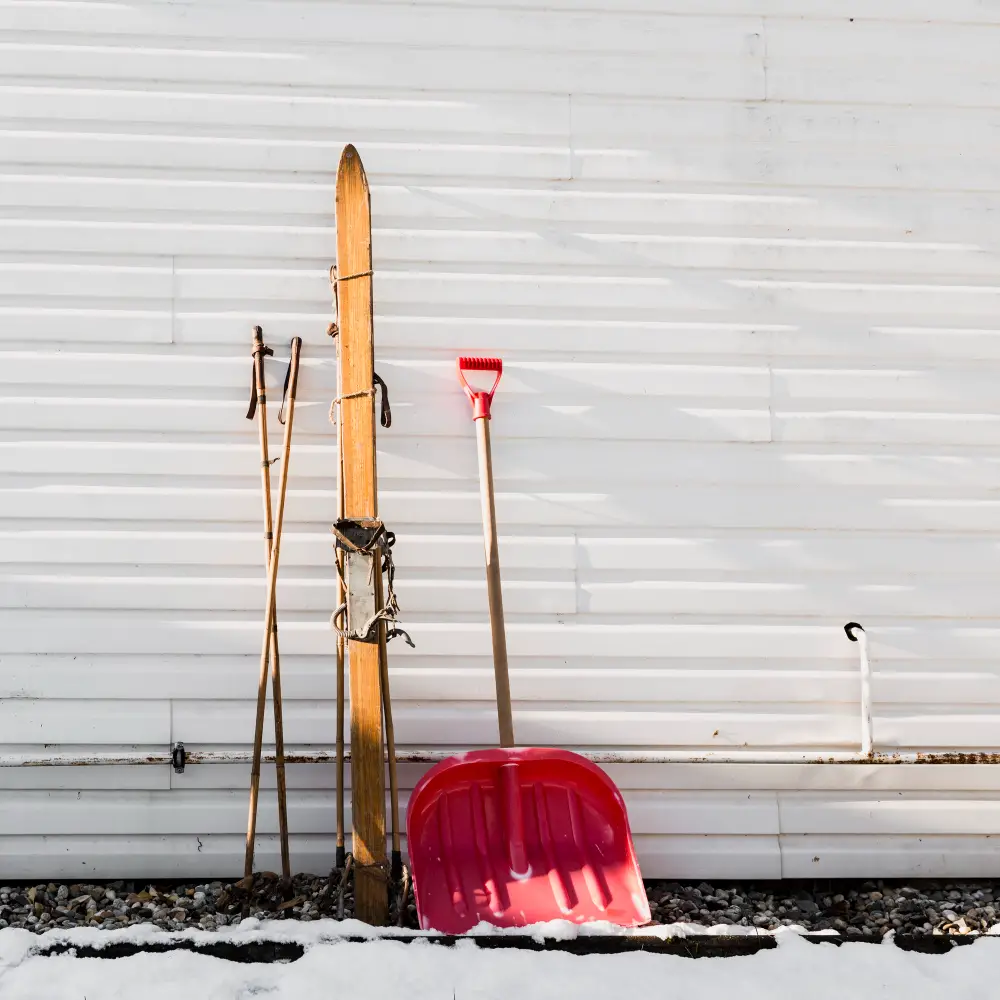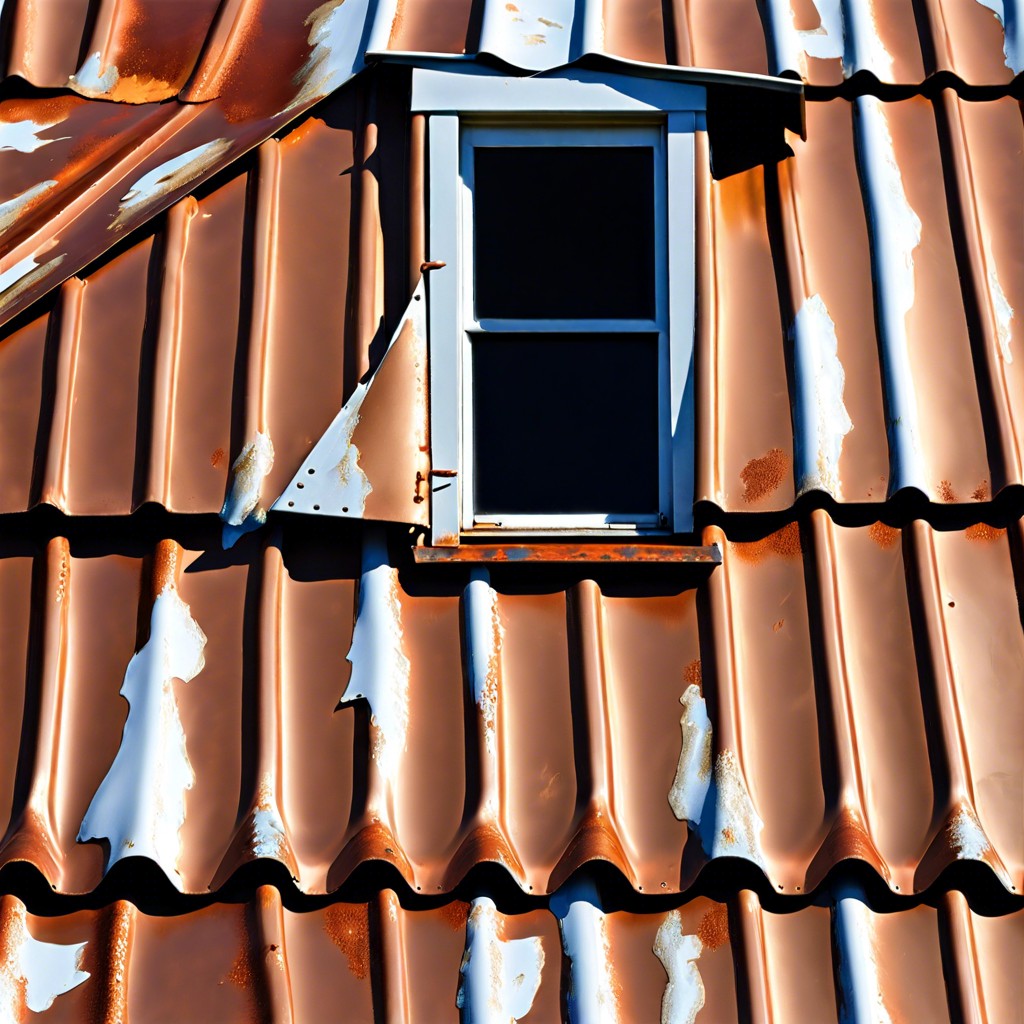Last updated on
Examining the unexpected First Avenue roof collapse becomes intriguing because of the various factors that contributed to its disastrous aftermath.
A sudden roof collapse on First Avenue disrupted the early morning calm, narrowly missing the onset of rush hour, when structural integrity gave way, seemingly succumbing to the relentless burden of heavy snow and the wear of aged materials.
This incident has ignited concerns about the safety of neighboring structures, prompting immediate assessments to mitigate further risks.
Now, with the community shaken, the imperative discussion about enhancing safety measures takes center stage, promising a reevaluation of inspection protocols and an overhaul of outdated building codes to safeguard against future catastrophes.
This article provides an in-depth look at the factors contributing to the collapse and explores the steps being taken to protect the area’s residents and infrastructure.
Key takeaways:
- Building collapse occurred on First Avenue.
- Collapse happened in the morning before rush hour.
- Possible causes include aged materials and heavy snow loads.
- Surrounding buildings being assessed for potential risks.
- Future safety measures may include stringent inspection schedules and modernizing building codes.
Incident Overview

On a bustling weekday afternoon in the heart of the city, a section of the roofing on the storied First Avenue building unexpectedly gave way. The incident occurred without warning, causing debris to scatter onto the street below. Fortunately, it was contained to a single building, allowing for rapid deployment of emergency responders.
The collapse not only halted the flow of traffic but also prompted a full evacuation of the premises. As authorities worked to secure the scene, efforts to assess the stability of the remaining structure began immediately, ensuring the safety of rescue workers and bystanders. Initial assessments suggest that no foul play was involved, turning the focus towards structural integrity and maintenance records.
The immediate aftermath of the collapse saw the community coming together, with local businesses and residents offering aid to those impacted.
Date and Time of the Collapse

On the morning of March 15th, around 9:30 AM, the structure succumbed to what appears to be a catastrophic failure, sending debris onto the street below.
The timing was particularly noteworthy as it occurred just before the peak of rush hour—fortunately avoiding a potentially higher number of casualties and injuries.
The day, known for its brisk weather, saw no immediate environmental stressors such as heavy snow or strong winds that often contribute to structural compromises, which has led to a focus on other underlying causes for the collapse.
Location of the Collapse
Situated in the heart of a bustling commercial district, the collapse occurred on one of the busiest thoroughfares in the city, intersecting with multiple key transit routes. Easily identifiable landmarks, including the historic theater and well-known shopping complex, flank the site.
This proximity to high-trafficked and culturally significant areas magnifies the urgency for structural assessments and reparative measures.
Access to several businesses within the vicinity is currently restricted as safety perimeters are established.
Public transport has been rerouted to accommodate the ongoing emergency response and preliminary investigations, with updates provided by city officials to assist in navigation and inform affected commuters.
Structural Failure: Initial Findings
Preliminary assessments indicate that a combination of aged materials and heavy snow loads may have contributed to the roof’s failure. Experts note that the weight of accumulated snow can strain structural elements, particularly in buildings with flat roofing systems where snow does not readily slide off.
Additional factors under review include possible corrosion of supporting beams and inadequate maintenance. Over time, weather elements and wear-and-tear can weaken critical components of a structure, increasing the risk of collapse.
Building codes require roofs to support specific weight loads; investigations are ongoing to determine if these standards were met or exceeded. Furthermore, the impact of any recent modifications or repairs to the roof structure is being closely scrutinized to evaluate their role in the collapse.
These initial findings serve as essential clues for investigators as they work to understand the root cause and prevent similar incidents.
Impact On First Avenue Traffic and Accessibility
The roof collapse on First Avenue has inevitably led to disruptions in both vehicle and pedestrian flow. Authorities have cordoned off the affected block to ensure public safety and facilitate emergency response operations.
Detour signs are in place, redirecting traffic to adjacent streets. Commuters should anticipate delays and may want to consider alternate routes or public transport options.
Businesses in the vicinity have been advised of potential access restrictions and are coordinating with local officials for deliveries and services. Pedestrians are urged to remain alert to changes in footpath accessibility and heed any barriers or instructions from officials on site.
Public transport users should check for service updates in case of route alterations.
Response By Emergency Services
Following the roof collapse on First Avenue, emergency services were quick to arrive at the scene. Their immediate action plan involved securing the perimeter to ensure public safety and prevent further incidents.
Teams meticulously searched the debris for any trapped individuals, providing urgent medical care to those affected. Firefighters and police worked in coordination to manage the crowd and reroute traffic, minimizing disruption.
Meanwhile, utility companies were called to address potential gas leaks or electrical hazards, ensuring the area was safe for investigators and cleanup crews. The presence of crisis counselors offered support to traumatized witnesses and victims’ kin.
The response was a testament to the preparedness and training of local emergency teams in the face of urban structural emergencies.
Eyewitness Accounts
Several onlookers provided firsthand accounts of the event, offering vivid descriptions of the moments leading up to, and following, the collapse. One bystander reported hearing a loud rumble before the collapse, likening it to the sound of thunder. Another mentioned the sight of dust clouds billowing as debris fell. Store owners adjacent to the building described feeling the ground shake, with one comparing the sensation to that of a minor earthquake.
Passersby recounted the immediate confusion and the rapid response of pedestrians helping to usher others away from the danger zone. These narratives contribute valuable perspectives to the investigation and humanize the incident beyond the structural analysis.
Casualties and Injuries
In the wake of the collapse, first responders swiftly conducted search and rescue operations to assess the human toll. Fortunately, the incident resulted in no fatalities, a testament to both luck and the effectiveness of emergency protocols.
Several individuals, however, sustained injuries ranging from minor abrasions to more serious, non-life-threatening traumas requiring hospital care. Local hospitals were on alert and quickly provided medical attention to those affected.
The psychological impact on witnesses and survivors is also being addressed, with counseling services made available through community support programs.
The exact number of injured parties was documented for further review as part of the ongoing investigation into the incident.
Building History and Previous Inspections
The structure in question dates back to the early 20th century, embodying a rich architectural legacy. Previous inspections, while sporadic, have documented concerns regarding the aging support beams and roof materials.
Records reveal that the last comprehensive assessment occurred over five years ago. Despite recommendations for maintenance, the full extent of restoration work required had not been undertaken, highlighting a possible oversight in preserving the building’s integrity.
The significance of regular, thorough inspections in such historic buildings cannot be overstated as they play a crucial role in preventing potential structural failures.
Official Statements From Local Authorities
Following the collapse, city officials promptly addressed the public to provide critical information and assurances regarding the incident.
- The mayor expressed solidarity with affected individuals and emphasized the gravity of the event.
- Building department representatives revealed plans for a thorough investigation to ascertain the collapse’s cause.
- Safety inspectors discussed immediate steps taken to assess surrounding buildings, ensuring no further risk to public safety.
- Public works officials outlined detour routes to mitigate traffic issues and facilitate emergency response.
- The fire department chief commended first responders and provided an update on the search and rescue operations.
- Health department officials offered guidance for those seeking medical attention or psychological support in the incident’s aftermath.
The collective message underscored a commitment to transparency and public safety while investigations are ongoing.
Investigations Into the Cause of the Collapse
Forensic engineers spearhead the probe, meticulously sifting through debris to uncover telltale signs of structural stress. Architects and construction experts join the effort, comparing original building plans with the site’s current state to identify discrepancies.
Materials scientists analyze fragments for evidence of fatigue, corrosion, or substandard materials that may have contributed to the failure. The role of weather, such as heavy snowfall or high winds, is examined in detail, as they can exacerbate existing vulnerabilities.
Throughout the investigation, building codes are scrutinized to ensure compliance and to determine if revisions are necessary to prevent future incidents. Data from local monitoring stations, including seismic activity or any construction work vibrations, are also being considered.
This thorough approach ensures a comprehensive understanding of the factors leading up to the collapse.
Implications for Nearby Structures
The unexpected collapse of the First Avenue roof has necessitated a thorough examination of adjoining buildings. Given the possibility of shared infrastructure or similar construction practices, it’s crucial for engineers and inspectors to assess these structures for potential risks.
This evaluation will focus on:
- Structural Integrity: Checking for any signs of stress, such as cracks or buckling, that could indicate a broader issue.
- Foundation Stability: Ensuring that the collapse hasn’t undermined the foundations of neighboring buildings.
- Vibrations and Shock Waves: Understanding how the collapse might have transmitted shock waves or vibrations that could weaken nearby structures.
- Compliance with Current Building Codes: Verifying that nearby buildings meet the latest safety standards to prevent similar incidents.
Authorities might enforce temporary closures or evacuations during these safety checks to ensure public welfare. Construction materials, design, and maintenance histories are also being reviewed to identify any systemic problems that could extend beyond the collapsed roof.
Future Safety Precautions and Building Codes
In the wake of the incident, heightened scrutiny will likely be applied to local building codes and safety regulations. Anticipated revisions may entail:
- Stringent Inspection Schedules: Increasing the frequency and thoroughness of building inspections to identify potential structural weaknesses.
- Modernizing Building Codes: Updating existing codes to incorporate contemporary safety standards and materials, ensuring resilience against heavy loads and extreme weather.
- Enforcement of Compliance: Ensuring all buildings, especially older ones, meet current safety standards through mandatory upgrades and penalties for non-compliance.
- Educational Outreach: Authorities may provide workshops and resources for property owners to understand their responsibilities and the importance of structural integrity.
- Emergency Preparedness: Developing contingency plans for prompt evacuation and response in case of similar incidents to minimize risk to human life.
These measures aim to bolster the safety and durability of buildings, thus safeguarding the well-being of the community.
Contact Information for Affected Individuals and Businesses
Individuals and businesses affected by the roof collapse on First Avenue can seek assistance and further information through several channels:
- Local Disaster Relief Services: These organizations provide temporary housing, food, and medical aid. Contact the nearest office for immediate support.
- Insurance Companies: Property and business owners should report the incident to their insurance providers as soon as possible to initiate the claims process.
- Building and Safety Department: For inquiries about structural assessments and permits for repairs, this department will offer guidance and necessary forms.
- Legal Assistance: Consultation with legal professionals can help in understanding rights and potential compensation mechanisms.
- Community Support Groups: Local groups may offer emotional support, advice, and resources for recovery.
- City Information Hotline: Stay updated on official announcements, road closures, and safety advisories by checking the city’s designated hotline or website.
For the most up-to-date contact details for these resources, please refer to the official First Avenue Roof Collapse Information Page or the local government website.
FAQ
Why did my ceiling fall down?
Your ceiling may have fallen due to a leakage or burst pipe, damage to the roof, or improper plumbing installation which needs prompt attention from an experienced local plumber.
Will my ceiling cave in?
Yes, if the water accumulates over time, the increased pressure can exceed the loadbearing weight of your ceiling, making it prone to collapse.
Can a roof cave in from rain?
Yes, a roof can potentially cave in from rain if the components of the roof become significantly saturated due to an untreated roof leak.
What are the warning signs of ceiling collapse?
Signs of a potential ceiling collapse include visible cracks in the ceiling, fractures in walls, or cracks in external masonry.
How does snow accumulation affect a roof’s structural integrity?
Snow accumulation puts an additional load on a roof, potentially compromising its structural integrity by causing deformations, cracks, or in severe cases, a total collapse.
What factors lead to a drastic roof collapse?
A drastic roof collapse can be precipitated by factors such as poor construction quality, heavy loads like snow or water accumulation, lack of regular maintenance, and the natural wear and tear caused by age and weather conditions.
Does inadequate roof maintenance accelerate ceiling deterioration?
Yes, inadequate roof maintenance does accelerate ceiling deterioration as it can lead to leaks and structural damage over time.




